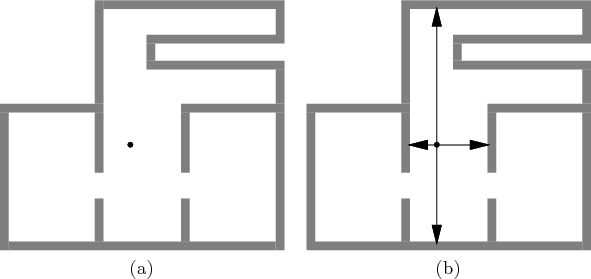
Next: Depth-mapping sensors Up: 11.5.1 Sensor Models Previous: Boundary sensors
Many important sensing models can be defined in terms of landmarks. A landmark is a special point or region in the state space that can be detected in some way by the sensor. The measurements of the landmark can be used to make inferences about the current state. An ancient example is using stars to navigate on the ocean. Based on the location of the stars relative to a ship, its orientation can be inferred. You may have found landmarks useful for trying to find your way through an unfamiliar city. For example, mountains around the perimeter of Mexico City or the Eiffel Tower in Paris might be used to infer your heading. Even though the streets of Paris are very complicated, it might be possible to walk to the Eiffel Tower by walking toward it whenever it is visible. Such models are common in the competitive ratio framework for analyzing on-line algorithms [674].
In general, a set of states may serve as landmarks. A common model is
to make ![]() a single landmark. In robotics applications, these
landmarks may be instead considered as points in the world,
a single landmark. In robotics applications, these
landmarks may be instead considered as points in the world, ![]() .
Generalizations from points to landmark regions are also possible.
The ideas, here, however, will be kept simple to illustrate the
concept. Following this presentation, you can imagine a wide variety
of generalizations. Assume for all examples of landmarks that
.
Generalizations from points to landmark regions are also possible.
The ideas, here, however, will be kept simple to illustrate the
concept. Following this presentation, you can imagine a wide variety
of generalizations. Assume for all examples of landmarks that
![]() , and let a state be denoted by
, and let a state be denoted by
![]() .
.
For the first examples, suppose there is only one landmark, ![]() ,
with coordinates
,
with coordinates ![]() . A homing sensor is depicted in
Figure 11.13 and yields values in
. A homing sensor is depicted in
Figure 11.13 and yields values in
![]() . The
sensor mapping is
. The
sensor mapping is
![]() , in which
, in which ![]() gives the angle in the proper quadrant.
gives the angle in the proper quadrant.
Another possibility is a Geiger counter sensor (radiation
level), in which
![]() and
and
![]() . In this
case, only the distance to the landmark is reported, but there is no
directional information.
. In this
case, only the distance to the landmark is reported, but there is no
directional information.
A contact sensor could also be combined with the landmark idea to
yield a sensor called a pebble. This sensor reports ![]() if the
pebble is ``touched''; otherwise, it reports 0. This idea can be
generalized nicely to regions. Imagine that there is a landmark
region,
if the
pebble is ``touched''; otherwise, it reports 0. This idea can be
generalized nicely to regions. Imagine that there is a landmark
region,
![]() . If
. If ![]() , then the landmark
region detector reports
, then the landmark
region detector reports ![]() ; otherwise, it reports 0.
; otherwise, it reports 0.
Many useful and interesting sensing models can be formulated by using the ideas explained so far with multiple landmarks. For example, using three homing sensors that are not collinear, it is possible to reconstruct the exact state. Many interesting problems can be made by populating the state space with landmark regions and their associated detectors. In mobile robotics applications, this can be implemented by placing stationary cameras or other sensors in an environment. The sensors can indicate which cameras can currently view the robot. They might also provide the distance from each camera.
 |
Steven M LaValle 2012-04-20